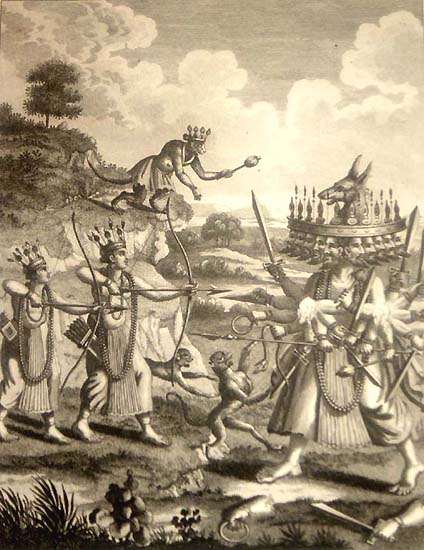India Through the Eyes of Europe - Rama Fighting Ravana
BY: SUN STAFF

[ Click for larger version ]
Jan 20, USA (SUN) — A great deal of Europe's interest in India was focused on South India, where great riches were acquired for the European market, and many souls were acquired by the missionaries, who were eager to convert the Hindus to Christianity.
As we read in the University of Chicago exhibition catalog referenced throughout this series, much of Europe's understanding of Brahminical practice came due to its experiences in the South of India.
"India's southeastern coast, often called Coromandel, was known to the Portuguese and the Jesuits of the sixteenth century only very superficially. In the following two centuries it was more closely investigated and commented upon in far greater detail by the English and Dutch who lived and worked in its port cities and hinterlands over long periods of time. Jesuit missionaries from Malabar and the Fishery Coast meanwhile crossed overland to Madura and other interior places of the south. Roberto dé Nobili, an Italian Jesuit and a staunch proponent of the policy of Christian accommodation to local conditions, set up a flourishing mission in Madura and environs in the first half of the seventeenth century. Meanwhile the Dutch preacher Abraham Roger (Rogerius) was investigating Hinduism at Pulicat in Tamilnadu between 1630 and 1640. His book on the beliefs and practices of south Indian Hinduism is called De open deure tot het verborgen Heydendom (Leyden, 1651), a book which really opened the door in Europe for an understanding of the Brahmanical faith. It was followed by the celebrated work (1672) by Philip Baldaeus, another Dutch missionary, which describes both of India's south coasts and Ceylon and provides additional information on the temples, gods, and ceremonies of the south Indian Hindus. The best book on northern Coromandel and on the sultanate of Golconda in its dying years was Daniel Havart's Op-en ondergang van Cormandel (Amsterdam, 1693).
Pastimes of Lord Ramacandra
As with yesterday's engraving, which depicted the Churning of the Milk Ocean, today's example is both a famous scene from Ramayana and an illustration of Lord Ramacandra from a Dasavatara series.
The Ramayana describes the Lord's incarnation as Rama, whose inconceivable activities culminated in killing the ten-headed demon, Ravana. Ravana had plagued the people, and seemed invincible to all who would take him down.
Ravana arranged for the kidnapping of Rama's consort Sita devi. Having been exiled to the forest, Ramacandra did not come after Ravana with his organized army. Instead, he organized a jungle army, and the monkeys fought under Hanuman, a great devotee of the Lord. Lord Rama conquered Ravana and Ceylon, built the great bridge of floating stones, and returned again to be installed with Sita after fourteen years.
Today's engraving of the battle scene between Rama and Ravana is a beautiful rendition of the lila pastimes. In typical European fashion, the natural setting is a somewhat odd mixture of English countryside and exotic India. In the background, the waters off the South coast of India can be seen. In the foreground, a small collection of unusual foliage gives the scene a taste of India.
Ravana is frightening with his ten crowned heads, atop which a most demoniac dog head is set. This demon-dog figure is a familiar device found in European Christian works that depict the devil.
As with Parasurama, Lord Rama's multi-arms are not well drawn, technically, being rather thick and stunted, and not very logically constructed. Along with other paraphernalia, Rava holds many swords. He is attacked by Lord Rama, Laksman and the monkey warriors. Two severed limbs lie on the ground, both proportionately large.
The Lord's crown in this engraving is more like the paraphernalia typically shown in Indian originals, and less like the crowns work by European royalty, helping to make the piece somewhat closer to the original images it aims to reproduce.
